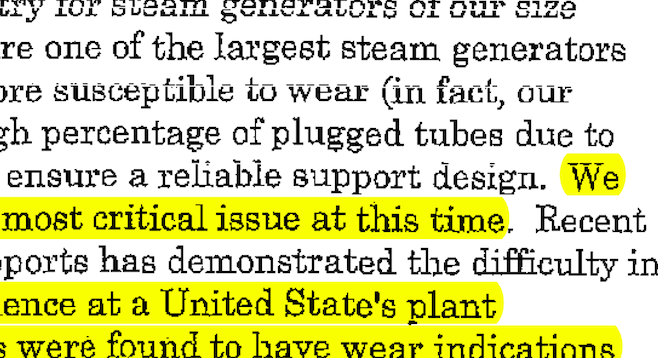 Facebook
Facebook
 X
X
 Instagram
Instagram
 TikTok
TikTok
 Youtube
Youtube

Information gleaned from a letter between San Onofre Nuclear Generating Station operator Southern California Edison and Mitsubishi Heavy Industries, manufacturer of the failed steam generators that shuttered to plant, could prove that Edison intentionally skirted federal design safety review requirements when ordering the new units.
The 2004 communication was released Wednesday by former Utility Consumers' Action Network executive Charles Langley who has been working with watchdog attorney Michael Aguirre to protest a $3.3 billion charge to ratepayers as a result of the plant's premature failure.
In the released letter, penned by Edison vice president Dwight Nunn, the utility executive notes that "questioning by San Onofre followed by an exhaustive evaluation by Mitsubishi Heavy Industries led to a design revision to address a potential risk to the success of the project."
"Changes in the steam generator design may be necessary," Nunn continues. "I am concerned that there is the potential that design flaws could be inadvertently introduced into the steam generator design that will lead to unacceptable consequences (e.g. tube wear and eventually tube plugging). This would be a disastrous outcome for both of us."
Indeed, federal Nuclear Regulatory Commission officials eventually concluded that flaws in the reactor's design were to blame for heavy premature wear in hundreds of steam tubes within the generators, though they stopped short of accusing Edison of making the changes without proper review, though that non-charge has long been disputed by critics and was repeated Wednesday.
"What all this means is that legally, [San Onofre] was an unlicensed reactor that was being illegally operated by Southern California Edison," says Langley. "They knew those generators were defective. They knew how to fix the problems of the defective generators in advance, but didn't. What's more, the engineers accurately predicted in advance where and how the generators would fail from the expected vibrations...yet [Edison's] executives proceeded to install them anyway."
The reasoning follows, then, that if Edison knew all along about the risks inherent in installing the new generators, and since those risks were quickly realized, shareholders in the parent companies that took those risks (including San Diego's Sempra Energy, which owns about 20 percent of the plant through its San Diego Gas & Electric subsidiary) should be the ones to pay for the utilities' poor decisions, not their customers.


Information gleaned from a letter between San Onofre Nuclear Generating Station operator Southern California Edison and Mitsubishi Heavy Industries, manufacturer of the failed steam generators that shuttered to plant, could prove that Edison intentionally skirted federal design safety review requirements when ordering the new units.
The 2004 communication was released Wednesday by former Utility Consumers' Action Network executive Charles Langley who has been working with watchdog attorney Michael Aguirre to protest a $3.3 billion charge to ratepayers as a result of the plant's premature failure.
In the released letter, penned by Edison vice president Dwight Nunn, the utility executive notes that "questioning by San Onofre followed by an exhaustive evaluation by Mitsubishi Heavy Industries led to a design revision to address a potential risk to the success of the project."
"Changes in the steam generator design may be necessary," Nunn continues. "I am concerned that there is the potential that design flaws could be inadvertently introduced into the steam generator design that will lead to unacceptable consequences (e.g. tube wear and eventually tube plugging). This would be a disastrous outcome for both of us."
Indeed, federal Nuclear Regulatory Commission officials eventually concluded that flaws in the reactor's design were to blame for heavy premature wear in hundreds of steam tubes within the generators, though they stopped short of accusing Edison of making the changes without proper review, though that non-charge has long been disputed by critics and was repeated Wednesday.
"What all this means is that legally, [San Onofre] was an unlicensed reactor that was being illegally operated by Southern California Edison," says Langley. "They knew those generators were defective. They knew how to fix the problems of the defective generators in advance, but didn't. What's more, the engineers accurately predicted in advance where and how the generators would fail from the expected vibrations...yet [Edison's] executives proceeded to install them anyway."
The reasoning follows, then, that if Edison knew all along about the risks inherent in installing the new generators, and since those risks were quickly realized, shareholders in the parent companies that took those risks (including San Diego's Sempra Energy, which owns about 20 percent of the plant through its San Diego Gas & Electric subsidiary) should be the ones to pay for the utilities' poor decisions, not their customers.
Comments